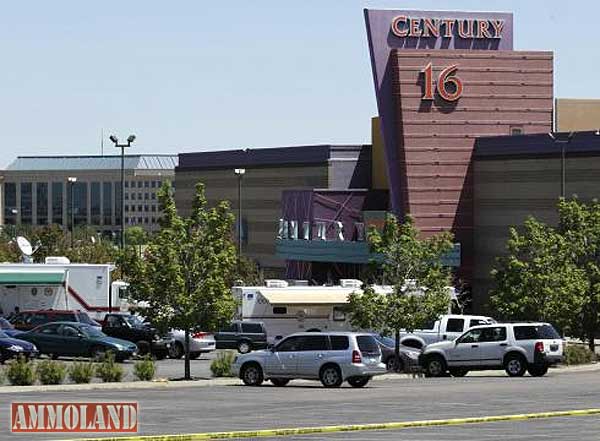By Paul Gallant, Sherry Gallant, Alan Chwick, & Joanne D. Eisen

Colorado –-(Ammoland.com)- There will always be evil people among us.
Witness all the genocides that occurred in the 20th century, murdering over 250 million innocent victims.
Evil people, no matter where they are found, have violent tendencies: they tend to turn on others, as the recent mass murder in the Century 16 Theater in Aurora, Colorado, shows.
And the firearm-prohibitionists eagerly await for these rare but heavily publicized atrocities to occur.
And occur they will!
They then stand by in the wings, ready to exploit them to the hilt. For example, the Brady Campaign, America’s largest lobby to prevent firearm-related violence, pledged “aggressive action.”
How come few of us never heard of the shooting that occurred, also in Aurora, earlier this year, “when there was only one victim, thanks to the quick thinking and action of a responsibly armed individual. Aurora police spokesman Frank Fania asked rhetorically: ‘Who knows what would’ve happened if the [church member, an off-duty police officer] had not been there? It certainly could have been a lot worse.’”
We need to understand, deep down inside us, that the statistics are on our side, that the benefits of private firearm ownership far outweigh their costs to society.
We really need to know that our Founding Fathers were correct when they inscribed the Second Amendment into our Bill of Rights. We also need to be as certain —and to be vocal about it— so that our friends, families, and communities know that we are all safer in homes, towns, cities, and countries where civilian firearm ownership is both lawful and commonplace.
The reason is simple: evil, violent people pick soft targets. These can be found in the elderly, in the infirm, in women, and in children. They can also be found in so-called “gun-free” zones where teachers, students, and lunchroom personnel are sitting ducks for those who wish them harm.
Or in places like the movie theater in Aurora, Colorado which prohibited lawfully armed Colorado citizen patrons, making the perfect soft target for the Dark Night Shooter.
The fact is that the areas which harbor the most restrictive firearm laws are the same places where there is a proliferation of firearms —especially those procured through the black market. To date, almost 40 states have enacted “shall-issue” (non-arbitrarily issued by the prevailing licensing authorities) concealed-carry laws.
Gun Free Killing Zones
School shootings are a prime example of how restrictive gun laws function exactly opposite to the claims of their proponents. In 1990, Federal legislation banning guns within 1,000 feet of a school was signed into law by then-President George Bush. Although ruled unconstitutional by the Supreme Court on April 25, 1995, the legislation was re-worked, resurrected by Congress, then signed back into law by Bill Clinton that same year.
In an April 1999 working paper entitled “Multiple Victim Public Shootings, Bombings, and right-to-Carry Concealed Handgun Laws”, by Dr. John R. Lott and colleague Dr. William Landes explored the phenomenon of mass public shootings in relation to the absence or presence of restrictive concealed handgun laws, enacted at the state level. Between 1977 and 1995, Lott and Landes found that 15 shootings took place in schools located in states with restrictive firearm laws, resulting in a total of 19 deaths and 97 injuries.
In contrast, only one shooting took place in a state where ordinary citizens had easy legal access to firearms, including concealed handguns.
The result: one death, and two injuries.
The difference was the factor of deterrence, brought about by armed, law-abiding citizens, and the possibility that would-be perpetrators might just run into one of these, instead of unarmed, defenseless victims.
Drs. Lott and Landes commented on the ramifications of banning guns in and around schools: “these incidents [e.g. “gun-free” public school zones, movie theaters, postal offices, establishments which have prominent signs telling prospective customers “No Guns Permitted Here!”] raise questions about the unintentional consequences of laws…The possibility exists that attempts to outlaw guns from schools, no matter how well meaning, may have produced perverse effects.”
The authors of the study pointed out that, 30 years ago, “nowhere were guns more common than at schools. Until 1969, virtually every public high school in New York City had a shooting club. High-school students carried their guns to school on the subways….”
If “easy access to guns” and their “proliferation,” and high-capacity magazines are the real problem, why did no school shootings in Stockton, CA back then? Why no school shootings in Littleton CO, back then? And how is it that first-graders didn’t go around shooting classmates back then?
In 1972, former West Yorkshire (England) Metropolitan Police Superintendent Colin Greenwood observed, more than a quarter century earlier: “One is forced to the rather startling conclusion that the use of firearms in crime was very much less when there were no controls of any sort and when anyone, convicted criminal or lunatic, could buy any type of firearm without restriction.”
Greenwood’s observation remains right on the money!
About the authors
Dr. Paul Gallant and Dr. Joanne D. Eisen practice optometry and dentistry, respectively, on Long Island, NY, and have collaborated on firearm politics for the past 20 years. They have also collaborated with David B. Kopel since 2000, and are Senior Fellows at the Independence Institute, where Kopel is research director. Most recently, Gallant and Eisen have also written with Alan J.Chwick. Sherry Gallant has been instrumental in the editing of virtually all of the authors’ writings, and is immensely knowledgeable in the area of firearm politics; she actively co-authored this article.
Almost all of the co-authored writings of Gallant, Eisen, Kopel, and Chwick can be found at www.gallanteisen.incnf.org, which contains more detailed information about their biographies and writing, and contains hyperlinks to many of their articles. Their recent series focusing on the Arms Trade Treaty can be found primarily at www.gwg.incnf.org.
